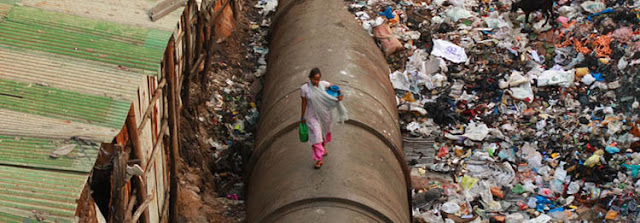India has 363 million (or 29.5 percent) people under the poverty line based on a survey of 2011-12, as against 407 million (37 percent) in 2004-05. This is latest claim that comes from the Rangarajan Committee in June 2014, until then it was pegged at 269 million (22 percent) using another formula. That’s enough for the comedy of poverty line in India! The more comprehensive Multidimensional Poverty Index 2013 report of UK based Oxford Poverty and Human Development Initiative (OPHI) and the United Nations Development Program (UNDP) says that 53.7 percent (or 650 million) people are poor. While there can never be agreement on poverty numbers, compare these numbers with the European Union and US populations of 500 million and 320 million, respectively.
Poverty in India is a historical reality. From late 19th century through early 20th century, under British colonial rule, poverty in India intensified, peaking in 1920s.Famines and diseases killed millions each time. After India gained its independence in 1947, mass deaths from famines were prevented, but poverty increased, peaking post-independence in 1960s. Rapid economic growth since 1991, has led to sharp reductions in extreme poverty in India.However, those above poverty line live a fragile economic life.Lack of basic essentials of life such as safe drinking water, sanitation, housing, health infrastructure as well as malnutrition impact the lives of hundreds of millions.
The World Bank reviewed and proposed revisions in May 2014, to its poverty calculation methodology and purchasing power parity basis for measuring poverty worldwide, including India. According to this revised methodology, the world had 872.3 million people below the new poverty line, of which 179.6 million people lived in India. In other words, India with 17.5% of total world's population, had 20.6% share of world's poorest in 2011.As of 2014, 58% of the total population were living on less than $3.10 per day .
One cause is a high population growth rate, although demographers generally agree that this is a symptom rather than cause of poverty. While services and industry have grown at double-digit figures, agriculture growth rate has dropped from 4.8% to 2%. About 60% of the population is employed in agriculture whereas the contribution of agriculture to the GDP is about 18%. The surplus of labour in agriculture has caused many people to not have jobs. Farming is strangulated by the government by not allowing economies of scale (Land Ceiling Act) thus not the use of machines and freeing up the labour for industrial production. The purchase of Agriculture land is not financed by banks which restricts enterprise in agriculture.
India has already made striking gains against extreme poverty, but the harsh reality is that 680 million of its citizens live with various forms of deprivation. If the country’s recent economic slowdown continues, it is likely that some 470 million of them would remain below the Empowerment Line in 2022, and 12 percent of the population could remain trapped in extreme poverty. But if the new government adopts an ambitious reform agenda and focuses on execution and results, India could be poised to take a historic step forward in its economic and human development — one that not only eradicates extreme poverty but also delivers better living standards to more half a billion people.
Sources: http://hubpages.com/politics/Reasons-Why-India-is-So-Poor
https://en.wikipedia.org/wiki/Poverty_in_India
http://www.huffingtonpost.com/entry/india-poverty-myths_b_5429858.html?section=india










0 comments:
Post a Comment